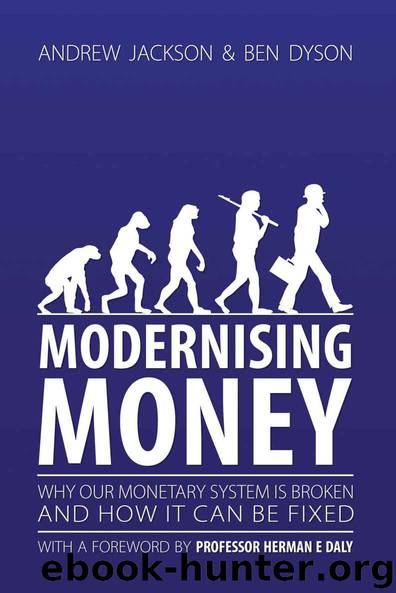Modernising Money: Why Our Monetary System is Broken and How it Can be Fixed by Jackson Andrew & Dyson Ben

Author:Jackson, Andrew & Dyson, Ben [Jackson, Andrew]
Language: eng
Format: epub
Publisher: Positive Money
Published: 2013-01-30T11:00:00+00:00
The power to shape the economy
The previous section showed that banks are able to use the funds that flow to them, as a result of payments made to their depositors, without the permission of the depositor. Yet the actual deposits themselves were created by banks through the process of making loans. Prior to Quantitative Easing, 97% of the UK’s money supply in the hands of the public existed in the form of deposits held by banks. That is, 97% of the money supply was created by private banks. In contrast, only 3% was created by the government – only 3% of the money supply is cash.
The banks therefore have massive power to shape the UK economy. This power is even greater than that of democratically elected government, because the banking sector allocates more money via lending than the government allocates via public spending. In the five years running up to the start of the financial crisis, the banking sector’s gross lending to households and individuals alone (not including lending to businesses) came to a total of £2.9 trillion. Meanwhile, total government spending during the same period was less at £2.1 trillion. Because the banks decide where to lend (for example, on housing, personal loans, car finance or investment in small businesses), they can shape much of the spending and activity in the economy. Indeed, as shown in section 4.1, if banks lend to productive business the economy will thrive. If instead they lend for speculative or non productive purposes earnings will stagnate, and rising debt will create recessions and potentially financial crises.
It is important to note that neither the quantity nor direction of bank lending is determined by ‘the market’. As shown in section 3.5 (on credit rationing), the quantity of lending is not determined by the interaction of the demand for, and supply of, credit. Instead, due to the fact that the level of the interest rate alters the probability of repayment, banks limit the interest rate they charge and instead ration credit. Banks determine the quantity of lending, and therefore the quantity of money and debt in the economy.
Likewise, the allocation of new lending is not determined by the relative returns on different projects. Rather, it is determined by the likelihood of repayment, and the ability to collateralise loans to ensure that non-repayment does not result in a loss to the bank. In fact, less than 10% of all bank lending today goes to businesses that contribute to GDP – the vast majority goes towards mortgages, real estate companies, and financial intermediation. If these lending decisions had been made by local bank managers who were in touch with the local economy and knew where any investment could be most productive, then banks having greater ‘spending power’ than government may not be such a matter for concern. However, lending decisions are not made by local branch managers, instead they are made by senior managers at the head offices of the banks, based on a statistical analysis of the relative likelihoods of repayment.
Download
This site does not store any files on its server. We only index and link to content provided by other sites. Please contact the content providers to delete copyright contents if any and email us, we'll remove relevant links or contents immediately.
International Integration of the Brazilian Economy by Elias C. Grivoyannis(91226)
The Radium Girls by Kate Moore(11921)
Turbulence by E. J. Noyes(7936)
Nudge - Improving Decisions about Health, Wealth, and Happiness by Thaler Sunstein(7615)
The Black Swan by Nassim Nicholas Taleb(7010)
Rich Dad Poor Dad by Robert T. Kiyosaki(6403)
Pioneering Portfolio Management by David F. Swensen(6226)
Man-made Catastrophes and Risk Information Concealment by Dmitry Chernov & Didier Sornette(5921)
Zero to One by Peter Thiel(5686)
Secrecy World by Jake Bernstein(4646)
Millionaire: The Philanderer, Gambler, and Duelist Who Invented Modern Finance by Janet Gleeson(4376)
The Age of Surveillance Capitalism by Shoshana Zuboff(4210)
Skin in the Game by Nassim Nicholas Taleb(4162)
Bullshit Jobs by David Graeber(4095)
The Money Culture by Michael Lewis(4076)
Skin in the Game: Hidden Asymmetries in Daily Life by Nassim Nicholas Taleb(3929)
The Dhandho Investor by Mohnish Pabrai(3699)
The Wisdom of Finance by Mihir Desai(3654)
Blockchain Basics by Daniel Drescher(3507)
